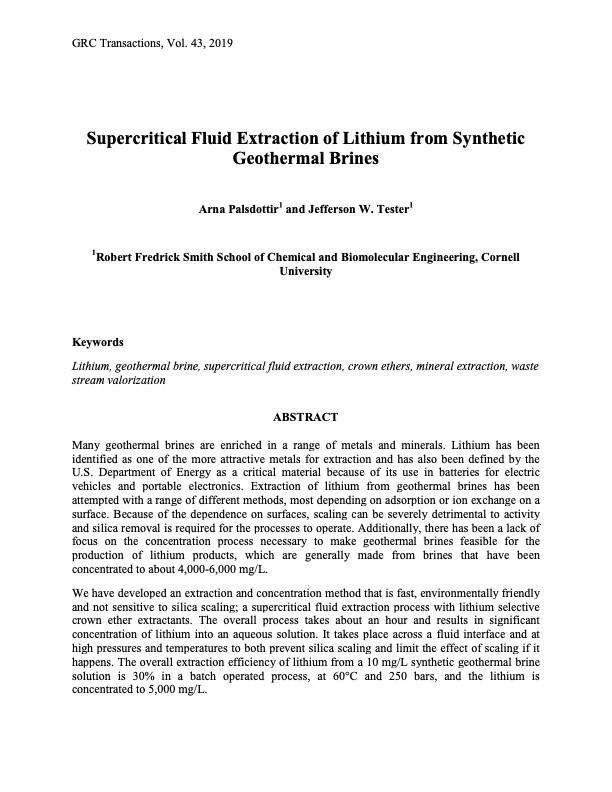
PDF Publication Title:
Text from PDF Page: 001
GRC Transactions, Vol. 43, 2019 Supercritical Fluid Extraction of Lithium from Synthetic Geothermal Brines Arna Palsdottir1 and Jefferson W. Tester1 1Robert Fredrick Smith School of Chemical and Biomolecular Engineering, Cornell University Keywords Lithium, geothermal brine, supercritical fluid extraction, crown ethers, mineral extraction, waste stream valorization ABSTRACT Many geothermal brines are enriched in a range of metals and minerals. Lithium has been identified as one of the more attractive metals for extraction and has also been defined by the U.S. Department of Energy as a critical material because of its use in batteries for electric vehicles and portable electronics. Extraction of lithium from geothermal brines has been attempted with a range of different methods, most depending on adsorption or ion exchange on a surface. Because of the dependence on surfaces, scaling can be severely detrimental to activity and silica removal is required for the processes to operate. Additionally, there has been a lack of focus on the concentration process necessary to make geothermal brines feasible for the production of lithium products, which are generally made from brines that have been concentrated to about 4,000-6,000 mg/L. We have developed an extraction and concentration method that is fast, environmentally friendly and not sensitive to silica scaling; a supercritical fluid extraction process with lithium selective crown ether extractants. The overall process takes about an hour and results in significant concentration of lithium into an aqueous solution. It takes place across a fluid interface and at high pressures and temperatures to both prevent silica scaling and limit the effect of scaling if it happens. The overall extraction efficiency of lithium from a 10 mg/L synthetic geothermal brine solution is 30% in a batch operated process, at 60°C and 250 bars, and the lithium is concentrated to 5,000 mg/L.PDF Image | Mining the Future Lithium

PDF Search Title:
Mining the Future LithiumOriginal File Name Searched:
1034174.pdfDIY PDF Search: Google It | Yahoo | Bing
Product and Development Focus for Infinity Turbine
ORC Waste Heat Turbine and ORC System Build Plans: All turbine plans are $10,000 each. This allows you to build a system and then consider licensing for production after you have completed and tested a unit.Redox Flow Battery Technology: With the advent of the new USA tax credits for producing and selling batteries ($35/kW) we are focussing on a simple flow battery using shipping containers as the modular electrolyte storage units with tax credits up to $140,000 per system. Our main focus is on the salt battery. This battery can be used for both thermal and electrical storage applications. We call it the Cogeneration Battery or Cogen Battery. One project is converting salt (brine) based water conditioners to simultaneously produce power. In addition, there are many opportunities to extract Lithium from brine (salt lakes, groundwater, and producer water).Salt water or brine are huge sources for lithium. Most of the worlds lithium is acquired from a brine source. It's even in seawater in a low concentration. Brine is also a byproduct of huge powerplants, which can now use that as an electrolyte and a huge flow battery (which allows storage at the source).We welcome any business and equipment inquiries, as well as licensing our turbines for manufacturing.| CONTACT TEL: 608-238-6001 Email: greg@infinityturbine.com | RSS | AMP |